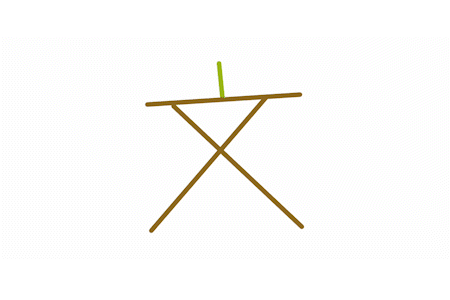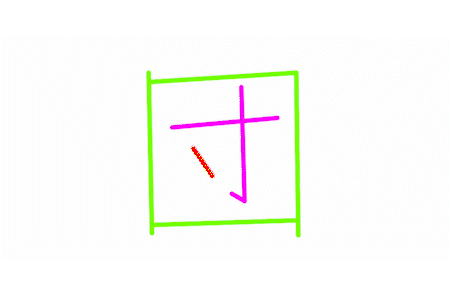バベルのランドスケープ
Landscapes of Babel (2025)
Video generated by original algorithm (11:04)
GengoRaw (石橋友也+新倉健人+吉田竜二)
GengoRaw (Tomoya Ishibashi+Kento Niikura+Ryuji Yoshida)


認知科学分野の研究成果を参照し、風景画像から抽出した線のパターンから、漢字文字を生成する映像作品。
岐阜県美術館での展示にあたって、岐阜県大垣市を結びの地とする『奥の細道』(松尾芭蕉, 1702年)を題材とした。芭蕉が江戸への帰路として下った大垣市の水門川の現在の光景から、『奥の細道』の冒頭箇所と芭蕉の詠んだ全俳句が含有する漢字文字を生成している。
文字言語は、思考を錬成し、社会生活を成立させ、書かれたものとしての記憶を集積し、人類の文明を根底で支えてきた。人類が発明した文字は、文明ごとに大変に異なっており、それらは複雑に分岐しながら、今日の文字となってきた。
2006年に認知科学者のマーク・チャンギージーらは、風景の中に現れる幾何学的パターンの分布とあらゆる言語の文字の中に現れる幾何学的パターンの分布が一致することを示した。この研究結果は、人類が身につけた自然を観察する能力に適応するように、文字の形が収斂進化していった可能性を示唆している。
本作では、チャンギージーらの研究で用いた3ストローク以内で構成可能な36個の幾何学パターンを風景から抽出し、漢字文字を生成している。高度に発達した言語は技術的発明の最たるものであるとみなすことができるが、実はそのすべてが人類を取り巻く世界の焼き直しなのかもしれない。
This video generates kanji characters from line patterns extracted from landscape images, referencing research findings in the field of cognitive science. For the exhibition at the Museum of Fine Arts,GIFU, it took as its subject The Narrow Road to the Deep North (Matsuo Bashō, 1702), which has ties to Ōgaki City, Gifu Prefecture. It generates kanji characters contained within the opening passage of The Narrow Road to the Deep North and all the haiku written by Basho, derived from the current scenery of the Suimon River in Ogaki City, which Basho traversed on his return journey to Edo.
Written language has forged thought, established social life, accumulated written memory, and fundamentally supported human civilization. The scripts invented by humanity vary greatly across civilizations, diverging complexly to become the scripts of today.
In 2006, cognitive scientist Mark Changizi and colleagues demonstrated that the distribution of geometric patterns appearing in landscapes matches the distribution of geometric patterns appearing in the characters of all languages. This research suggests that character shapes may have converged evolutionarily to adapt to humanity's innate ability to observe nature.
This work extracts 36 geometric patterns, each composed of three strokes or fewer as identified in Changizi's research, from landscapes to generate Chinese characters. While highly developed languages can be regarded as the pinnacle of technological invention, perhaps they are all merely reinterpretations of the world surrounding humanity.


IAMAS ARTIST FILE #10 繭/COCOON: 技術から思考するエコロジー/Thinking Ecology through Technics
岐阜県美術館/Museum of Fine Arts, GIFU. January 10 - March 9, 2025
Photo by Satoshi Fukushima
System

3ストローク以内で構成される36個の幾何学パターン。Changizi et al (2006)を元に、色付けして再構成。
36 geometric patterns composed of three strokes or fewer. Reconstructed and colored based on Changizi et al (2006).



本作の解析・制作にあたり、
KanjiVG (https://kanjivg.tagaini.net/)をもとに、最小限の画数で構成した漢字フォント2136文字を独自に開発した。
For the analysis and production of this work,
we independently developed a kanji font consisting of 2,136 characters, based on KanjiVG (https://kanjivg.tagaini.net/) and composed with the minimum number of strokes.
データマイニング、画像処理、API開発:Python
アプリケーション開発:HTML/CSS/JavaScript
References
-
Changizi, M. A., & Shimojo, S. (2005). Character complexity and redundancy in writing systems over human history. Proceedings of the Royal Society B: Biological Sciences, 272(1560), 267–275. https://doi.org/10.1098/rspb.2004.2942
-
Changizi, M. A., Zhang, Q., Ye, H., & Shimojo, S. (2006). The Structures of Letters and Symbols throughout Human History Are Selected to Match Those Found in Objects in Natural Scenes. The American Naturalist, 167(5), 117–139. https://doi.org/10.1086/502806
-
マーク・チャンギージー. (2020). ヒトの目、驚異の進化: 視覚革命が文明を生んだ (柴田裕之訳). 早川書房.